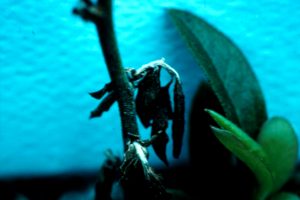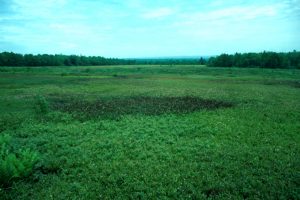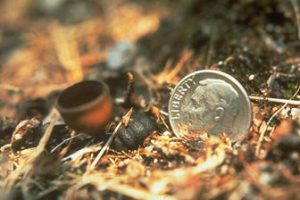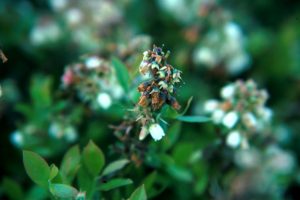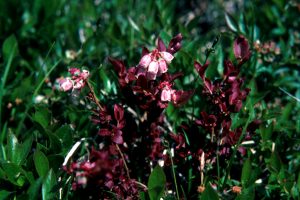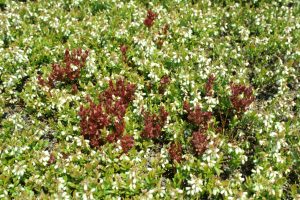211-Blueberry Diseases 1
Fact Sheet No. 211, UMaine Extension No. 2015
Prepared by David H. Lambert, Assistant Professor of Plant Pathology, in cooperation with Tom DeGomez, Extension Blueberry Specialist, The University of Maine, Orono, ME 04469. March 1987. Photo credits: A.W. Stretch (1,4), J.F. Dill (2,3), D. Yarborough (5), R.S. Byther (6), D.H. Lambert (7a, 7b, 8).
Mummy Berry
Pathogen: Monilinia vaccinii-corymbos
Symptoms/disease cycle: Initial symptoms of the disease appear two to three weeks before full bloom when affected leaves wilt and dry to a medium brown (Figure 1). On some leaves, only the center of the leaf may show reddish-brown symptoms. Infections can spread from leaves to twigs. The disease may appear in patches of a foot or more across (Figure 2). From a distance, this symptom will resemble blossom blight or spanworm damage. Correct identification is essential for proper control. In the second stage of the disease, cream-colored spores (conidia) produced at the base of diseased leaves are blown or carried by insects to blossoms and immature fruit. The infection spreads around the developing berry (Figure 3), which becomes a hard shriveled, pumpkin-shaped, pinkish gray sclerotium. Sclerotia survive the winter in the layer of fallen leaves and, if the soil remains wet long enough in the spring, these germinate to produce goblet-shaped apothecia (Figure 4). While most germination occurs after a single winter, some sclerotia remain dormant for another year or two. During the periods of wet weather, apothecia release ascospores for approximately one month, starting at bud break. Ascospores infect swelling buds or new leaves. The two major factors required for the disease are the presence of sclerotia from a previous crop and periods of cool, wet weather.
- Figure 1. Initial symptoms of the disease appear two to three weeks before full bloom when affected leaves wilt and dry to a medium brown.
- Figure 2. The disease may appear in patches of a foot or more across.
- Figure 3. In the second stage of the disease, cream-colored spores (conidia) produced at the base of diseased leaves are blown or carried by insects to blossoms and immature fruit.
- Figure 4. Sclerotia survive the winter in the layer of fallen leaves and, if the soil remains wet long enough in the spring, these germinate to produce goblet-shaped apothecia.
Botrytis Blight
Pathogen: Botrytis cinerea
Symptoms/disease cycle: The fungus Botrytis causes a bloom blight but may also infect leaves and stems (Figure 5). Fruit infection is usually not a problem until storage for fresh market. Weak or injured tissue is particularly susceptible, and mature or frost-damaged blossoms are most affected. One week after infection, single blossoms or cluster turn light brown and develop a grayish-brown mold which is easy to see with low powered magnification (Figure 6). In contrast to flowers that have not been pollinated, dead blossoms remain attached. Blossom blight may be distinguished from frost damage by the presence of the fungus on blossoms and by the lack of frost damage on other plants in the area. Since clones vary considerably in susceptibility to Botrytis blossom blight, the appearance of the disease may also be patchy. Blossom blight fungus is able to grow in dead or dying material of many plant species, so the disease may develop from spores produced on dead blueberry leaves or stems in the field, or from spores blown from nearby fields, or from spores blown from nearby fields or woods.
When temperatures are in the 60’s a wet or foggy period of at least one day is required for infection to occur. Longer wet periods are required in cooler weather.
- Figure 5. The fungus Botrytis causes a bloom blight but may also infect leaves and stems.
- Figure 6. Blossoms or cluster turn light brown and develop a grayish-brown mold.
Red Leaf
Pathogen: Exobassidum vaccinii
Symptoms: Most leaves of affected plants are red to beet red (Figures 7a and b). Some may appear normal, others may be partially affected with distinct irregular red blotch (Figure 7a). Later in the season, a white layer of spores develops on the underside of the leaves (Figure 7b). Few or no fruit develop, and some twigs may be killed. In the field, diseased stems often occur by themselves in clusters coming from the same rhizome. In some cases, the disease will appear in patches that may be a foot or more across (Figure 8).
Disease cycle: When leaves are affected by fungus spores, they do not immediately develop symptoms of red-leaf. The fungus invades the stem and rhizome and spreads back into leaves after a period of several months. The disease persists in the stems and rhizomes from year to year.
- Figure 7a. Most leaves of affected plants are red to beet red.
- Figure 7b.
- Figure 8.
Information in this publication is provided purely for educational purposes. No responsibility is assumed for any problems associated with the use of products or services mentioned. No endorsement of products or companies is intended, nor is criticism of unnamed products or companies implied.
© 1987
Call 800.287.0274 (in Maine), or 207.581.3188, for information on publications and program offerings from University of Maine Cooperative Extension, or visit extension.umaine.edu.
The University of Maine is an EEO/AA employer, and does not discriminate on the grounds of race, color, religion, sex, sexual orientation, transgender status, gender expression, national origin, citizenship status, age, disability, genetic information or veteran’s status in employment, education, and all other programs and activities. The following person has been designated to handle inquiries regarding non-discrimination policies: Director of Equal Opportunity, 101 Boudreau Hall, University of Maine, Orono, ME 04469-5754, 207.581.1226, TTY 711 (Maine Relay System).

